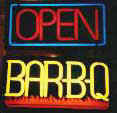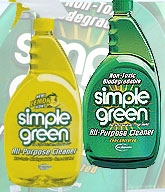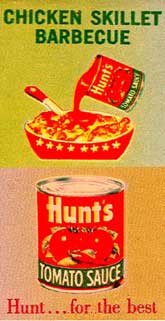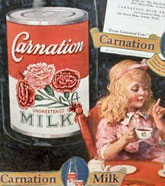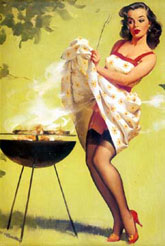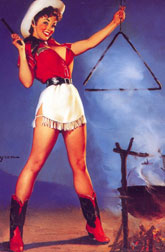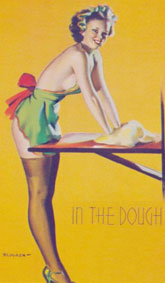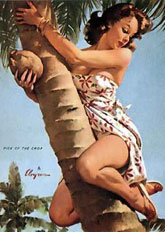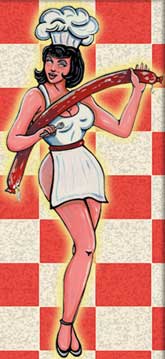Contact BBQbyDan
www.BBQDan.com
Search
KCBS BBQ Cook-Off Info
Recipes,
Smoking Meats
Recipes, Grilling
|
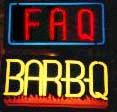 |
FAQ OF THE INTERNET BBQ LIST Version 2.0 Section 8 Wood For Smoking |
8.1 Types of wood suitable for smoking
-------------------[Would someone please tell me what kinds of wood are suitable for smoking?]
The traditional woods for smoking are HICKORY and OAK. Here is a list of woods suitable for smoking:
ACACIA - these trees are in the same family as mesquite. When burned in a smoker, acacia has a flavor similar to mesquite but not quite as heavy. A very hot burning wood. ALDER - Very delicate with a hint of sweetness. Good with fish, pork, poultry, and light-meat game birds. ALMOND - A sweet smoke flavor, light ash. Good with all meats. APPLE - Very mild with a subtle fruity flavor, slightly sweet. Good with poultry (turns skin dark brown) and pork. ASH - Fast burner, light but distinctive flavor. Good with fish and red meats. BIRCH - Medium-hard wood with a flavor similar to maple. Good with pork and poultry. CHERRY - Mild and fruity. Good with poultry, pork and beef. Some List members say the cherry wood is the best wood for smoking. Wood from chokecherry trees may produce a bitter flavor. COTTONWOOD - It is a softer wood than alder and very subtle in flavor. Use it for fuel but use some chunks of other woods (hickory, oak, pecan) for more flavor. Don't use green cottonwood for smoking. CRABAPPLE - Similar to apple wood. GRAPEVINES - Tart. Provides a lot of smoke. Rich and fruity. Good with poultry, red meats, game and lamb. HICKORY - Most commonly used wood for smoking--the King of smoking woods. Sweet to strong, heavy bacon flavor. Good with pork, ham and beef. LILAC - Very light, subtle with a hint of floral. Good with seafood and lamb. MAPLE - Smoky, mellow and slightly sweet. Good with pork, poultry, cheese, and small game birds. MESQUITE - Strong earthy flavor. Good with beef, fish, chicken, and game. One of the hottest burning. MULBERRY - The smell is sweet and reminds one of apple. OAK - Heavy smoke flavor--the Queen of smoking wood. RED OAK is good on ribs, WHITE OAK makes the best coals for longer burning. All oak varieties reported as suitable for smoking. Good with red meat, pork, fish and heavy game. ORANGE, LEMON and GRAPEFRUIT - Produces a nice mild smoky flavor. Excellent with beef, pork, fish and poultry. PEAR - A nice subtle smoke flavor. Much like apple. Excellent with chicken and pork. PECAN - Sweet and mild with a flavor similar to hickory. Tasty with a subtle character. Good with poultry, beef, pork and cheese. Pecan is an all-around superior smoking wood. SWEET FRUIT WOODS - APRICOT, PLUM, PEACH, NECTARINE - Great on most white or pink meats, including chicken, turkey, pork and fish. The flavor is milder and sweeter than hickory. WALNUT - ENGLISH and BLACK - Very heavy smoke flavor, usually mixed with lighter woods like almond, pear or apple. Can be bitter if used alone. Good with red meats and game.BBQ List members report that wood from the following trees is suitable for smoking:
BAY, CARROTWOOD, KIAWE, MADRONE, MANZANITA, GUAVA and OLIVE. The ornamental varieties of fruit trees (i. e. pear and cherry) are also suitable for smoking.Other Internet sources list the wood from the following trees as suitable for smoking:
BEECH, BUTTERNUT, FIG, GUM, CHESTNUT, HACKBERRY, PIMIENTO, PERSIMMON, and WILLOW. ==============Dave Klose--
On the subject of barbecue woods, I have found the best results to be from nut and fruit-bearing trees, cut down from 6 months to 2 years ago. I have found that wood over two years old tends to produce a dirty taste in the food more often than not. Wood can be cut down whole, and split after five or so months of seasoning. I recommend splitting three days or so before cooking with it.
HERBS and SPICES - Don't forget you can add soaked garlic, peppers, onions, herbs, and spices directly to your fire. Good with all meats and vegetables. Try using apple chips soaked in water, placed on the coals when you cook duck or goose in your smoker. It will taste like you rubbed your bird with honey. Delicious. Also try smoking a cherry pie on pecan wood. Great.
==============Editor--
Although the experienced wood-burners on the List will say you should use wood for smoking that has been seasoned for less than two to three years, older wood can certainly be used for smoking. It will have very little smoky flavor left but it will provide good heat for your smoker. Just add some flavor wood chunks, such as hickory, oak or grapevines, to get that good smoke flavor. So if your neighbor gives you a cord of ancient oak, take it! Just be prepared to have to add some younger wood chunks to your fire to give you some flavor.
-------------------[Where can I find woods suitable for barbecue?]
Randy Dewberry--
Most barbecue wood is purchased from firewood dealers, but make sure that you let your relatives, friends, neighbors and co-workers know that you are always looking for fruit woods and hardwoods. Let them know what size you might need. As an example, if you let them know that even trimmings would be nice, you can collect a quite variety of wood types. You will be surprised at the number sources that turn up. So far I have pecan, apple, pear and plum.
Editor--
If you cannot find a source of barbecue wood in the yellow pages, go to a barbecue joint in your area and ask them where they get their wood. They will be able to tell you what kind of wood is available and where to get it and how much they have to pay for it.
Also, check out this Web site for detailed information on how to buy wood from a
dealer.
![]() Click here
Click here
[I just got a load of mixed hardwood. It all looks the same. The bark on the hickory looks smoother than the oak but I can't visually tell the difference between the oak and hickory. Can somebody help?]
Rock McNelly--
Just looking at the bark, it really is hard to tell the difference between hickory and oak, and I have a less than a perfect record guessing between them! But what I have found to work, almost 100% of the time, is to take a lighter and burn the edge of the wood just enough to release that good aroma that each one has. Hickory will jump out at you like a freight train! While the oak will be just a bit more subtle about it. Another idea is to make yourself sort of a "catalog" of the different woods once you've positively identified a chunk of it. Use a piece of plywood, or something similar, and mount chunks of each wood, with the bark on them. Put the name under each piece. Keep the catalog near your wood pile for easy reference.
==============Editor--
The Audubon Society publishes a series of field guides. The tree guides have pictures of trees along with pictures of their bark to help you tell one tree from another.
--------------------[Can someone tell me about the BTU content of the different smoking woods?]
Danny Gaulden--
I'm going to make this simple for you. Pound for pound, all woods create the same amount of BTUs. Does this mean that a cord of seasoned pine puts out the same amount of heat as a cord of seasoned hickory? No! The hickory will produce twice the amount of BTU's of the pine because it weights roughly twice as much as the pine.
So if one threw three 18 inch long, 4 inch round, seasoned hickory logs into their wood-burning smoker, they would create about twice the heat of three pine logs the same size, for the hickory is much denser and heavier. But, if one was to put 20 pounds of pine, or 20 pounds of hickory into the firebox, the overall heat would be the same. Now understand the pine would burn much faster, and give off a lot of heat quickly, then die down, whereas the hickory would burn much more slowly, and give off its heat at a slower rate. By the way, pound for pound, green wood gives off much less BTUs than seasoned wood, for it takes a lot of the heat energy to evaporate the moisture out of the green wood (i.e. turn it to steam). Do not ever use pine for barbecuing--I'm only using it here to show the differences in wood density.
==============Ed Pawlowski--
A cord of hardwood is about 12,500,000 BTUs of heat.
A hundred gallons of heating oil is 13,600,000 BTUs of heat.
Natural gas has a 1000 to 1100 BTUs per cubic foot.
Propane has 2519 BTUs per cubic foot or 21,670 BTUs per pound or 92,600 BTUs per gallon.
Note that the hardwood is an estimate that will vary depending on how tightly it is stacked, the mix of wood, and the seasoning of the wood.
As long as I'm tossing numbers, a ton of coal is 25,000,000 BTUs and a pound of Styrofoam is 18,400 BTUs.
So, to answer the original question, the harder the wood the more power is packed into the same volume. Wood density can vary considerably in the same tree so you will find little specific information about the heat content of a species.
--------------------[I have this wild cherry that has been down for a couple years. It is not rotten but it is blackened on the ends from the weather and has a few soft spots where ants have gotten into it. OK to use it for smoking?]
Danny Gaulden--
All seasoned woods tend to turn a dark color on the ends. If the areas where the insects have eaten are airy and spongy, then do away with them. I see no reason why you can't use the good areas for barbecuing.
The only thing that concerns me about using wood that is very seasoned is that it tends to burst into flame quickly rather than burn slowly. The problem this creates can be a serious one if you're not careful. When the old seasoned wood ignites, it can cause a fast rise in temperature in the smoker, causing it to overheat. Most folks want to quickly close down the air damper, which causes the fire to starve and create creosote. Creosote is a very unforgiving enemy of barbecue, for it only takes a minute or two for it blacken and foul the meat in the smoker. Once this happens, you can wipe and wash off the meat all day long, but it will never be the same. The oily, stinky smell will be on and in the meat. I didn't read this from a book, I learned it the hard way many years ago. You must be very careful when using very seasoned wood, as well as green wood. So if you get a flare-up, open the firebox door to let out some of the heat, rather than shutting down the air inlet damper.
If you are going to use the wood for smoking only, and have another kind of heat source (charcoal, gas, electricity), then the cherry wood shouldn't present a problem. Being as old as it is, soak it in water overnight, or for several hours before adding it to the heat source. It would probably be wise to wrap it in foil and punch a couple of very small (toothpick size) holes in it. You will be amazed at how much smoke will come out of these two little holes. Make too many holes in the foil, and the wood will stand a much greater chance of catching fire.
-------------------[I'm new at the burning wood in my barbecue smoker. Can you give me some general information about wood?]
Danny Gaulden on wood--
Wood Storage:
Once the wood has been split, it must be stacked to dry or season. Drying occurs more rapidly along the grain. Therefore don't stack the wood for drying until it is split. Avoid damp places or depressions where water will collect after a rainfall. The pile should be free-standing with maximum exposure to air and sunlight. A tarp over the wood pile in rainy season helps keep it dry.
Green Wood:
Green wood can be as much as 65 percent water. Much of this moisture evaporates very quickly. In three months of reasonable weather (evaporation depends on temperature and humidity), the seasoning is half complete and the fuel value is 90 percent of what it will be when thoroughly dry; in two years the wood is as dry as it will get.
There is an appreciable difference in BTU rating for woods burned green or air-dried. Completely dry hardwood has about 7850 BTU's per pound whereas green wood when burned loses over one-eighth (1200 BTU's per pound) in evaporating the moisture.
It requires no work to let the wood sit for at least a year. In the process you are increasing the heat value, the wood will be lighter, ignite better, and produce less smoke and fewer sparks. Wood will dry faster if it is split. Much depends on the humidity and the weather in your area. In some areas in May and June, wood will dry rapidly, it will reabsorb water in July and August, dry out again in September, reabsorb water in October. Potentially wood can increase its moisture content if not properly stored.
Drying can be hastened if the pile is stacked criss-cross for three months, then stacked in the normal parallel fashion. Green wood is easy to identify. Just split a piece. The core will look wet and shiny; dry wood looks dull and the saw marks are less pronounced. Green wood is almost twice as heavy as seasoned wood and will make a dull thud when two green sticks are hit together. It is hard to handle, hard to light, and burns slowly. Much of its energy is lost in heating, then evaporating the excess moisture. As wood dries, the moisture evaporates naturally and the wood begins to shrink. Wood, even when air-dried, is still has 20-25 percent moisture content. Since wood shrinks unevenly, cracking and checking of the wood occurs. Dried wood can be recognized by the weathered ends, and by the cracks which will radiate like spokes out from the heartwood.
Buying Wood:
The delivery of wood is not yet a regulated business. Whether you are actually "taken" or not, you probably will think so. One delivery won't appear as large as the next, will be piled differently if at all, and may have assumed another name by the time it arrives. Wood is sold by the truck load, by weight, in cords, ricks, runs, or units. All this is as confusing to the wood-burner as to many dealers. Others simply take advantage of the fact that most homeowners don't know the difference between wood species or understand wood measurements. Wood usually is sold in divisions of a STANDARD CORD which is a neatly stacked pile eight feet long by four feet wide by four feet high with a volume of 128 cubic feet. Since wood can't be stacked without air space, only 60-110 cubic feet of the 128 may be solid wood. (Usually it runs between 80-90 cubic feet with more solid wood content in round wood than split.) A FACE CORD is also called a RICK or a PALLET and is one-half a standard cord. There is a considerable difference in weight between woods; a standard cord of air-dried hardwood weighs about 4,000 pounds while a standard cord of softwood will weigh half that.
-------------------[Can you give me some pointers on buying and stacking wood?]
Ed Pawlowski--
Buying hardwood is a lot like buying a used car. Except a used car is easier and the dealer more honest. Some states regulate how wood is sold--it can be sold as a cord, 128 cubic feet or fraction thereof, but not a pickup truck load, or by weight. For smoking or for your wood stove or fireplace, you want hardwood. Often, you can specify what species of wood you want, but you will pay two to four times as much as you'd pay for a mixed load of hardwood.
Most dealers sell green wood, that is, it is recently cut, not aged. Seasoned wood will cost more, especially in the winter when it is in demand. Other sections of the FAQ discuss as to how long wood should be seasoned for smoking so I will not go into it here. Burning for heat, it should be seasoned at least six months, preferably a year. Wood cut in the spring contains more moisture and will take longer to season than wood cut in the winter. That is because the tree is taking water to nourish itself and grow leaves.
The dealer may offer 4-ft. log length, cut-to-length (usually 16"), or cut, split, and delivered. Each step involves more labor and drives up the cost. Even if you buy split wood, you may want to split it more for use in the smoker. The quartered wood is good for a stove, but smoke cooking is a different operation that requires adding smaller pieces of wood. Splitting also aids drying as more surface area is exposed to the air.
Green wood means it was recently cut. Seasoned wood means the same wood will cost you about $30 a cord more. Do pay attention to the dealer before he drops the wood. Check the measure and check the age. Seasoned wood, if it honestly is, will have cracking on the ends of the logs. It may also be darkened and weathered. Smack two pieces together, a 'thud' sound indicates the wood is green, a 'thunk' indicates dry wood. Well-seasoned wood has a ring to it when hit together. If you handle enough of it, you can tell how dry it is by feel or heft.
Assuming the wood is bought at a fair price, let's get on with splitting and storing. Hickory is more difficult to split than oak or maple. Some woods are "stringy" and would be harder to split. If that is the case, try to cut the logs to a shorter length.
In all cases, wear GLOVES, SAFETY GLASSES and preferably hard tipped shoes and long pants. Logs do fall, fly and move around when split. So do the tools. Get the kids and dog out of the way. Be sure your wife is also taking precautions as she stacks the wood for you. Get her a good pair of gloves for her dainty hands. I've never had much luck with using wedges. When I first started using wood, I had a wedge, a sledge, and countless trips to the store for new hickory handles. Close don't count splitting wood and a heavy sledge will only take a few over-hits before the handle breaks.
I bought a maul. The first handle (hickory) lasted two years. I replaced it with a fiberglass handle and have been using it for over a dozen years now. First, put the wood to be split on top of a stump or other large piece of wood. You want the maul handle to be perpendicular to the wood when it hits the target. This increases the accuracy and exerts maximum force to the wood. Next, practice. The wood I split is 16" long and various thicknesses. A large diameter piece may take a few smacks, but a 12' dia. piece will go in half with one good hit of the maul.
If you live in the northern climes, a good time to split the wood is when the it is frozen in winter. It gives a cleaner cut and takes less force to do the same work. Very green wood is stringy and more difficult than wood that is a couple of months old. Hickory, especially with knots, is a pain to split clean. Oak is much easier.
Now that it is split, what to do with it? Keep some of the medium sized logs that were cut in two. Using them as a base, flat side down, make a small stack alternating the direction of the wood 90 degrees each layer. Take some time to use the flattest and squarest pieces for this role. This is going to be the end of the stack and is known as chimney stacking. Lay the other pieces in between, not too snug. You want air to circulate. This should be done on a solid base of concrete, stone, or old pallets. Keep the wood off the ground or it will rot and collect more bugs. Don't stack more than about 4' high. Be sure the pile is stable as wood is heavy and a falling stack could injure a curious child or pet. No one should be playing around the wood pile.
Do not stack the wood right up against your house or garage. This invites all sorts of bugs and other creatures to make the wood in your home into a meal. Don't be surprised to find a nest or two as you use up the wood months after stacking. Maybe even a snake skin left over from the shedding. In summer, leave the wood exposed to the sun. There is no advantage to covering to speed drying with either clear or black plastic. In fall, you may want to keep leaves off the wood and in winter, keep the rain and snow off if you expect to use it for heating. The logs will freeze together. This is not a problem for smoking next summer, only for immediate winter use.
==============Bill Wight--
There is a wood splitting wedge called the "Wood Grenade". It is a 4-sided wedge and does a much better job than the standard flat wedge on hard to split wood. I've never buried the Wood Grenade in a log like I have with standard wedges. The log splits before the Wood Grenade gets all the way into the log.
-------------------[I was cutting up some smoking wood with my chainsaw and I had this big pile of cutting chips/sawdust on the ground. Is this stuff good for making smoke for smoking or grilling?]
Wyndell Ferguson--
While I was doing all this cutting, I figured what the heck, I put down a tarp where I was cutting and saved all the saw dust/chips also! I have two 5 gallon buckets full of the stuff. I use it on my gas grill when we do burgers and such.
==============Ed Pawlowski--
I do the same thing when I cut up wood. Hey, its good wood so why waste it? It makes smoke and gets the job done.
-------------------[The guy who sold me some pecan wood for barbecuing, said not to use it for the entire smoking time as my barbecue would taste like pecans. Any truth to this?]
Garry Howard--
Danny Gaulden only cooks with pecan wood and his barbecue certainly does not taste like pecans. You're being fed some hogwash. Pecan is very similar to hickory but a little milder. It's my favorite wood and there certainly isn't a problem using it throughout the entire cooking process.
===============Danny Gaulden--
Pecan is one of the best smoking woods. No, your meat will not taste like pecans. This is basically the only wood I have been using for the past few years. Contrary to popular belief, it is not that mild of a smoking wood and yields an excellent flavor. It is less bitter than hickory, but with a bit of the same flavor, and in my opinion, it is just a tad stronger than oak or apple. Where the idea that it is a "cool" burning wood got started, I will never know. It makes good coals, and burns as hot as any other hardwood in its class.
Editor--the woods used for smoking do not give the meat the flavor of the type of fruit or nut the wood came from--almond wood does not make the meat taste like almonds and lemon wood does not give the meat a citrus taste.
--------------------
[When I smoke with a wood fire, should I leave the bark on or remove it?]
Beverly Collins--
I learned the hard way--ruining some good meat in my smoker by leaving on the bark. Now I save the pieces with the bark on and use for my grilled meat. Seems to work fine there where I am depending on burning the wood to coals instead of smoking.
==============Rick Thead--
I don't worry about the bark. I've read posts that said to take it off. It might depend on the nature of the fire. As I've said, I prefer a clean burn and can get away with the bark on since I have a large smoker. Under these conditions, I don't find that I have a problem with the bark. On other types of smokers, there might be a problem with bitter taste.
==============M. Bedouin--
To me it doesn't make a difference--bark on or off.
==============Harry Jiles--
IMHO, the bark can add a bitter taste to the meat. Someone else might know more about this and can correct me if I am wrong, but I was told this was due to the tannic acid which the bark contains. I remove all bark from the wood I use in my smoker.
==============Ed Pawlowski--
There was a discussion in 1996 on the List about bark giving the meat a bitter taste. If I recall, it was never completely settled. I leave the bark on the wood if it does not come off easy. Can't say as I ever noticed a taste difference, bark on or bark off.
==============Rodney Leist--
Like green vs. dry, this debate is never over. Most folks probably don't think too much about this one but some feel the burning bark can produce a bitter taste. You decide.
Rodney Leist--
This seems to be like a religious debate. Many excellent barbecuers and restaurants advocate one or the other. Some say green wood tends to produce a bitter creosote taste due to saps in the wood, while others say the saps produce the best flavor.
==============Dave Klose--
You can use some woods green for smoking, but under no circumstances should you use green mesquite for smoking. It will produce a bitter taste in the pit for years that cannot be sandblasted out. People have used this before because they saw someone in a restaurant using it. That was grilling with it, not smoking.
==============Editor--
We recommend that the beginning barbecuer use only seasoned wood until he or she gets some experience in smoking with a wood-burning smoker. Using green wood without knowing what you are doing is a quick way to ruin barbecue.
8.4 What types of wood should I not use?
Dave Klose--
Don't use any wood from conifers (PINE, FIR, SPRUCE, REDWOOD, CEDAR, CYPRESS, etc.). I saw a man cook with the heart of pine one time that promoted some of the nastiest red splotches all over the skin of the unhappy diners--made them extremely sick.
==============Editor--
There are many trees and shrubs in this world that contain toxins to humans--toxins that can survive the burning process. Remember, you are going to eat the meat that you smoke and the smoke particles and chemicals from the wood and what may be on or in the wood are going to get on and in the meat. Use only wood for smoking that you are sure of. If you have some wood from a tree and know its name but don't know if it's good for smoking, ask the BBQ List. If no one's ever used that wood, DON'T use it.
It is beyond the scope of this FAQ to provide a complete listing woods that are unsuitable for smoking. If you have some wood and do not know what it is, DO NOT USE IT FOR SMOKING FOOD. Burn it in your fireplace but not your smoker.
List members report that ELM and EUCALYPTUS wood is unsuitable for smoking, as is the wood from SASSAFRAS, SYCAMORE and LIQUID AMBER trees.
Here are some more woods that you should not to use for smoking:
1 Never use lumber scraps, either new or used. First, you cannot know for sure what kind of wood it is; second, the wood may have been chemically treated; third, you have no idea where the wood may have been or how it was used. For all you know, that free oak planking could have been used in a sewage treatment plant.
2 Never use any wood that has been painted or stained. Paint and stains can impart a bitter taste to the meat and old paint often contains lead.
3 Do not use wood scraps from a furniture manufacturer as this wood is often chemically treated.
4 Never use wood from old pallets. Many pallets are treated with chemicals that can be hazardous to your health and the pallet may have been used to carry chemicals or poison.
5 Avoid old wood that is covered with mold and fungus that can impart a bad taste to your meat. If you have some good cherry wood (or other good smoking wood) that is old and has a fungus growth and you want to use it, pre-burn it down to coals before you put it into your smoker.
8.5 How do I start my wood or charcoal fire?
-------------------[What's the best way to start the fire in my wood-burning smoker?]
Editor--summary of several posts--
Use the old tee-pee method with kindling. Put two balled-up sheets of newspaper in the firebox and then stack up kindling (1/4 to 1/2 inch diameter x 6 inches long) in a tee-pee shape over the newspaper, smaller stuff first then bigger pieces. Light the newspaper and keep the fire going with progressively bigger pieces of wood until you have some nice coals and can put on your logs.
For those without fire building skills, a propane gas burner works well for lighting fires in your smoker. You can use all kinds of burners from the small soldering torches to weed-burners. Safety first here though.
Some List members put an electric charcoal lighter rod into the kindling pile and when the rod is red hot and the wood smoldering, blow on it to get a flame. Remove the electric rod when the fire is going well.
Paraffin fire starters are used by some List members. You can buy them in a camping supply store or make your own. See post below.
==============Rock McNelly--
I don't know how this would work for charcoal, but we used to make our own fire starters as a kid out of paraffin wax, saw dust, and egg cartons. We'd cook up some wax, stir in the saw dust, and then fill the little "cups" of the paper egg cartons. Then, when we wanted to start a fire, we'd just cut off one of the "cups", and place it under the kindling and light it. It would last a long time, and I can't recall a time that it didn't get the fire going. If nothing else, it'll give you something to do on a rainy weekend afternoon!
-------------------[Is there no odor from the paraffin fire starters?]
Vince Vielhaber--
They smoke some, but not much odor. I usually leave the firebox door open when I'm using one of these paraffin starters because of the smoke and then close the door when they are burned and the fire is started.
Another List member recommended pitch logs (pine saturated with natural pitch) to start the fire. Make sure that the pine and pitch are burned and gone before putting the meat in the smoker.
Some List members use charcoal lighter fluid to start the wood or charcoal in their pits. Just be sure that the fire burns long enough to eliminate all the volatiles from the lighter fluid so they don't give any bad tastes to your meat--wait at least 30 minutes after the last use of the lighter fluid. NEVER use gasoline or any other flammable liquids to start your smoker fire--only use commercial charcoal lighter fluids.
8.6 How much does lump charcoal and smoking wood cost?
-------------------[How much does lump charcoal cost?]
Editor--A summary of several posts--
List members report lump charcoal prices in bags of 20 pounds to be between $6 and $10 per bag (in early 1998). In 40 pound bags it can be a little cheaper per pound, running $10 to $18 per bag. the larger to package size, the cheaper per pound. Shop around as prices in a single city can vary 50-80%.
-------------------[How much does smoking wood cost?]
Prices for smoking hardwoods will vary with your location. Prices are as of early 1998 include delivery and splitting. Where there is lots of hardwood, like in parts of the south, hickory can cost you as little as $75 a cord. In Carlsbad NM, you can buy a cord of pecan for $110. In the hill country of Texas, you can get a cord of oak for $80. In Southern California, where hardwoods are scarce, a cord of oak or mesquite costs $400, a cord of almond about $280. In Virginia, a mixed cord of hickory and oak runs $135. In central Illinois, a cord of mostly oak with some hickory and maple mixed in runs $90-100. In western Connecticut, a cord of oak with a little hickory and maple thrown in will cost you about $90. In Southern Oregon, a cord of oak runs $120, pear wood about $150.
-
Return to the Table of Contents
Return to the BBQ FAQ Home Page
Comments or Suggestions
BBQ FAQ Ver 2.0 ©1997, 1998 William W. Wight. All rights reserved.

